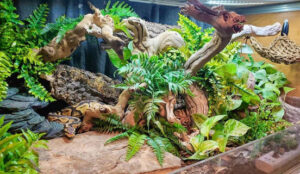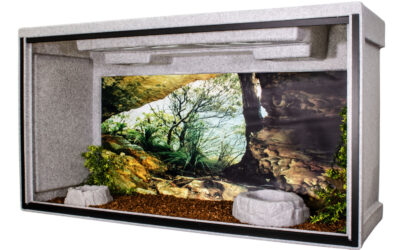What size tank for ball python is a crucial query for any reptile enthusiast stepping into the world of ball python ownership. Ensuring an appropriate enclosure size is fundamental to the health and well-being of these captivating creatures.
The ideal tank size for a ball python largely depends on the snake’s age, size, and activity level. As a general rule of thumb, a young ball python (less than a year old) can thrive in a 20-gallon tank, while adult ball pythons typically require at least a 40-gallon tank or larger.
However, bigger is often better, as ball pythons enjoy exploring their environment and need ample space to stretch out and thermoregulate. Additionally, providing height and width in the enclosure is essential for creating a stimulating and enriching habitat.
What size tank for ball python?

For a single adult ball python, a tank size of at least 40 gallons is recommended. However, larger is always better. Here’s why:
- Space Requirement: Ball pythons are not extremely active snakes, but they do need enough space to move around, stretch out, and explore. A larger tank allows them to exhibit more natural behaviors, such as climbing and exploring.
- Temperature Gradient: A larger tank provides more space to create a proper temperature gradient. Ball pythons require a warm side and a cool side in their enclosure to regulate their body temperature effectively. A larger tank allows for better distribution of heat sources and helps maintain the necessary temperature gradient.
- Humidity Regulation: Ball pythons also require a specific level of humidity to stay healthy and shed properly. A larger tank makes it easier to maintain humidity levels, as there is more surface area for water to evaporate from, reducing the risk of stagnant air and mold growth.
- Enrichment: Providing environmental enrichment is important for the well-being of captive reptiles. A larger enclosure allows for more hiding spots, branches, foliage, and other elements that can stimulate your ball python mentally and physically.
- Health and Stress Reduction: Inadequate space can lead to stress and health issues in ball pythons, such as respiratory infections and improper shedding. A larger enclosure reduces stress and promotes overall health and well-being.
While a 40-gallon tank is suitable for an adult ball python, bigger enclosures, such as those measuring 75 gallons or more, are even better. Additionally, always ensure proper husbandry practices, including correct temperatures, humidity levels, and substrate, regardless of the tank size.
Factors to Consider When Choosing Tank Size
When choosing the tank size for a ball python, several factors should be considered to ensure the snake’s health and well-being:
- Size of the Snake: Consider the current size of the ball python and its expected adult size. Ball pythons can grow to be around 3 to 5 feet long as adults, so you’ll need a tank that accommodates their eventual size.
- Activity Level: While ball pythons are not particularly active snakes, they still require enough space to move around, stretch out, and explore their environment. A larger tank allows for more natural behaviors and provides mental stimulation.
- Temperature Gradient: Ball pythons require a temperature gradient in their enclosure, with a warm side for digestion and a cooler side for thermoregulation. A larger tank provides more space to create a proper gradient and ensures the snake can regulate its body temperature effectively.
- Humidity Needs: Proper humidity levels are essential for ball pythons to shed properly and maintain respiratory health. A larger tank allows for better humidity regulation, as there is more surface area for water to evaporate from.
- Enclosure Accessories: Consider the space needed for substrate, hides, branches, and other enrichment items. These accessories provide hiding spots, climbing opportunities, and mental stimulation for the snake. A larger tank allows for more enrichment options.
- Future Growth: It’s essential to consider the ball python’s growth potential when selecting a tank size. Investing in a larger enclosure from the beginning can save money and hassle later on as the snake grows.
- Ease of Maintenance: Larger tanks may require more effort to clean and maintain compared to smaller ones. Consider your ability to provide proper care and maintenance for the chosen tank size.
- Budget and Space: Larger tanks can be more expensive and may take up more space in your home. Consider your budget and available space when choosing the appropriate tank size.
By considering these factors, you can select a tank size that meets the needs of your ball python and provides a comfortable and enriching environment for its growth and well-being.
Recommended Tank Sizes for Different Life Stages
Recommended tank sizes for different life stages of a ball python typically vary based on the snake’s size and growth rate. Here’s a general guideline:
- Hatchling to Juvenile (0-12 months):
- Tank Size: 20-30 gallons
- As hatchlings, ball pythons can start in smaller enclosures, such as a 20-gallon tank. As they grow, you may need to upgrade to a 30-gallon tank within the first year.
- Subadult (1-2 years):
- Tank Size: 30-40 gallons
- As the ball python continues to grow, a larger enclosure becomes necessary. A 40-gallon tank is suitable for most subadult ball pythons.
- Adult (2+ years):
- Tank Size: 40-75 gallons or larger
- Adult ball pythons require more space to accommodate their size and provide adequate enrichment. A 40-gallon tank is the minimum recommended size for an adult, but larger tanks, such as 75 gallons or more, are preferable for long-term housing.
Additionally, providing ample hiding spots, climbing opportunities, and enrichment items within the enclosure is crucial for the snake’s well-being, regardless of the tank size. Always monitor your ball python’s behavior and adjust the enclosure size as needed to ensure it remains healthy and comfortable throughout its life.
Common Mistakes to Avoid

When setting up and maintaining a tank for a ball python, it’s important to avoid common mistakes to ensure the snake’s health and well-being. Here are some common pitfalls to avoid:
- Inadequate Tank Size: One of the most common mistakes is housing a ball python in a tank that is too small. Always provide an enclosure that allows the snake to stretch out fully and move around comfortably.
- Incorrect Temperature and Humidity Levels: Maintaining proper temperature and humidity levels is essential for the health of a ball python. Avoid keeping the tank too hot or too cold, and ensure humidity levels are within the appropriate range (around 50-60%).
- Poor Substrate Choice: Using the wrong substrate can lead to respiratory issues or impaction if ingested by the snake. Avoid substrates like cedar or pine shavings, and opt for safe options such as aspen shavings, cypress mulch, or coconut husk.
- Inadequate Hiding Spots: Ball pythons are shy snakes that require multiple hiding spots in their enclosure. Make sure to provide at least two hides—one on the warm side and one on the cool side—to allow the snake to feel secure.
- Overhandling: Handling a ball python too frequently or roughly can cause stress and lead to defensive behavior. Limit handling to a few times per week and always handle the snake gently and with care.
- Improper Feeding Schedule: Feeding too frequently or offering prey that is too large can lead to obesity or regurgitation. Follow a proper feeding schedule based on the snake’s age and size, and offer appropriately sized prey.
- Neglecting Veterinary Care: Regular veterinary check-ups are important for monitoring the snake’s health and addressing any potential issues early on. Don’t wait until the snake is visibly sick to seek veterinary care.
- Ignoring Behavioral Cues: Ball pythons may exhibit behavioral cues, such as refusing food or spending excessive time in their hides, that indicate stress or health issues. Pay attention to these cues and adjust husbandry as needed.
By avoiding these common mistakes and providing proper care and husbandry, you can create a healthy and thriving environment for your ball python.
Tips for Creating an Optimal Habitat Setup
Creating an optimal habitat setup for a ball python involves several key factors to ensure the snake’s health, comfort, and well-being. Here are some tips for setting up an ideal habitat:
- Selecting the Right Enclosure: Choose a tank that is appropriate for the snake’s size and provides ample space for movement and enrichment. A glass terrarium or PVC enclosure with secure locking mechanisms is recommended.
- Proper Substrate: Use a safe and appropriate substrate that mimics the snake’s natural habitat and helps maintain humidity levels. Aspen shavings, cypress mulch, coconut husk, or paper towels are popular substrate choices for ball pythons.
- Temperature Gradient: Create a temperature gradient within the enclosure by providing a heat source on one side (such as an under-tank heating pad or ceramic heat emitter) and a cooler area on the other side. Use a digital thermometer to monitor temperatures and ensure they are within the appropriate range (around 75-80°F on the cool side and 85-90°F on the warm side).
- Humidity Control: Maintain proper humidity levels (around 50-60%) by misting the enclosure regularly and providing a large water dish for the snake to soak in. Covering part of the tank’s screen lid can help retain humidity, but ensure there is still adequate ventilation to prevent respiratory issues.
- Hiding Spots: Offer multiple hiding spots throughout the enclosure, including one on the warm side and one on the cool side. Use a variety of hides, such as half logs, caves, or commercially available reptile hides, to provide options for the snake to feel secure.
- Enrichment and Décor: Add branches, plants, and other décor to the enclosure to create a stimulating and naturalistic environment for the snake. Avoid using live plants that may be toxic to reptiles, and ensure all décor is securely anchored to prevent accidental falls or injuries.
- Proper Lighting: While ball pythons do not require UVB lighting, providing a low-wattage incandescent or LED bulb can help simulate a day-night cycle and provide additional heat if needed. Ensure there are areas of the enclosure where the snake can retreat from direct light if desired.
- Feeding Area: Designate a specific area of the enclosure for feeding to help reduce stress and prevent accidental ingestion of substrate. Use a separate feeding container or a feeding mat to offer prey items, and remove any uneaten food after feeding.
- Regular Maintenance: Clean the enclosure regularly to remove waste, shed skin, and any uneaten food. Spot clean as needed and perform a deep clean with a reptile-safe disinfectant on a regular basis to maintain a clean and hygienic habitat.
By following these tips and providing a well-designed and properly maintained habitat, you can create an optimal environment for your ball python to thrive in captivity.
Conclusion
What size tank for ball python? Choosing the right tank size is crucial for the health and well-being of your ball python. A tank of at least 40 gallons is recommended for adult snakes, providing ample space for movement, temperature gradients, and enrichment.
Larger tanks offer even better living conditions. Ensuring proper husbandry practices alongside appropriate tank size is essential for your ball python’s overall health and happiness.

